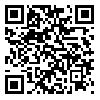Thu, Jan 1, 2026
Volume 30, Issue 1 (1-2020)
JHNM 2020, 30(1): 17-26 |
Back to browse issues page
Download citation:
BibTeX | RIS | EndNote | Medlars | ProCite | Reference Manager | RefWorks
Send citation to:



BibTeX | RIS | EndNote | Medlars | ProCite | Reference Manager | RefWorks
Send citation to:
Mirzaei S, Eftekhari A, Mohammadinia L, Dehghani Tafti A A, Norouzinia R, Nasiriani K. Comparison of the Effect of Lecturing and Tabletop Exercise Methods on Level of Preparedness of Nurses against Natural Disasters. JHNM 2020; 30 (1) :17-26
URL: http://hnmj.gums.ac.ir/article-1-1091-en.html
URL: http://hnmj.gums.ac.ir/article-1-1091-en.html
Samaneh Mirzaei1 

 , Adel Eftekhari1
, Adel Eftekhari1 

 , Leila Mohammadinia *2
, Leila Mohammadinia *2 

 , Abbas Ali Dehghani Tafti3
, Abbas Ali Dehghani Tafti3 

 , Roohangiz Norouzinia4
, Roohangiz Norouzinia4 

 , Khadijeh Nasiriani5
, Khadijeh Nasiriani5 




 , Adel Eftekhari1
, Adel Eftekhari1 

 , Leila Mohammadinia *2
, Leila Mohammadinia *2 

 , Abbas Ali Dehghani Tafti3
, Abbas Ali Dehghani Tafti3 

 , Roohangiz Norouzinia4
, Roohangiz Norouzinia4 

 , Khadijeh Nasiriani5
, Khadijeh Nasiriani5 


1- Ph.D. Health in Emergency and Disaster, School of Public Health, Shahid Sadoughi University of Medical Sciences, Yazd, Iran.; Research Development Center, Shahid Rahnemoon Hospital, Shahid Sadoughi University of Medical Sciences, Yazd, Iran.
2- Department of Health Emergencies and Disasters, Health Human Resources Research Center, School of Management and Information Sciences, Shiraz University of Medical Sciences, Shiraz, Iran. ,Leyla.mohammadinia@gmail.com
3- Associate Professor, Department of Health in Emergency and Disaster, School of Public Health, Shahid Sadoughi University of Medical Sciences, Yazd, Iran.
4- Department of Health in Emergencies and Disaster, School of Management and Medical Information, Isfahan University of Medical Sciences, Isfahan, Iran.
5- Associate Professor, Department of Nursing, Nursing and Midwifery School, Shahid Sadoughi University of Medical Sciences and Health Services, Yazd, Iran.
2- Department of Health Emergencies and Disasters, Health Human Resources Research Center, School of Management and Information Sciences, Shiraz University of Medical Sciences, Shiraz, Iran. ,
3- Associate Professor, Department of Health in Emergency and Disaster, School of Public Health, Shahid Sadoughi University of Medical Sciences, Yazd, Iran.
4- Department of Health in Emergencies and Disaster, School of Management and Medical Information, Isfahan University of Medical Sciences, Isfahan, Iran.
5- Associate Professor, Department of Nursing, Nursing and Midwifery School, Shahid Sadoughi University of Medical Sciences and Health Services, Yazd, Iran.
Abstract: (3458 Views)
Introduction: Hospitals are the first-line care providers in natural disasters. Nurses, as one of the critical health professional groups, require adequate peroration for responding to natural disasters. Due attention has to be paid to various teaching methods to improve the level of nurses’ preparedness.
Objective: This study compared the effect of lecturing and lecturing-tabletop exercise methods on the level of nurses’ preparedness against natural disasters.
Materials and Methods: In this quasi-experimental study, 74 nurses were randomly selected from different wards at a hospital in Yazd City, Iran, in 2017. Nurses’ preparedness level was measured with the 72-item Scale for Nurses’ Preparedness against Natural Disasters, including three areas of knowledge, attitude, and performance. The study participants were assigned into group A (lecturing method, n=37) and group B (lecturing-tabletop exercise method, n=37) using a simple random sampling technique. Nurses’ level of preparedness was measured three times (pre- and post-intervention, and follow-up) using the Preparedness for Disasters questionnaire. The obtained data were analyzed applying repeated measures Analysis of Variance (ANOVA) and Paired Samples t-test.
Results: The mean scores of nurses’ knowledge, attitude, and performance were increased by 4.94, 7.38, and 5.59 in group A as well as 6.56, 11.43, and 6.08 in group B. Additionally, the total score of nurses’ preparedness in group B was significantly higher at Pre-test, post-test, and one-month follow-up (107.89±7.50) (P=0.0001).
Conclusion: Education ( lecturing and lecturing-tabletop exercise methods) positively affected nurses’ preparedness. However, it was more effective through lecturing-tabletop exercise methods due to having a scenario and the better participation of nurses in the learning process. This finding emphasizes the positive effect of participants’ interactions in the tabletop exercise method on the quality of education, critical skill, and increased level of nurses’ preparedness against natural disasters.
Objective: This study compared the effect of lecturing and lecturing-tabletop exercise methods on the level of nurses’ preparedness against natural disasters.
Materials and Methods: In this quasi-experimental study, 74 nurses were randomly selected from different wards at a hospital in Yazd City, Iran, in 2017. Nurses’ preparedness level was measured with the 72-item Scale for Nurses’ Preparedness against Natural Disasters, including three areas of knowledge, attitude, and performance. The study participants were assigned into group A (lecturing method, n=37) and group B (lecturing-tabletop exercise method, n=37) using a simple random sampling technique. Nurses’ level of preparedness was measured three times (pre- and post-intervention, and follow-up) using the Preparedness for Disasters questionnaire. The obtained data were analyzed applying repeated measures Analysis of Variance (ANOVA) and Paired Samples t-test.
Results: The mean scores of nurses’ knowledge, attitude, and performance were increased by 4.94, 7.38, and 5.59 in group A as well as 6.56, 11.43, and 6.08 in group B. Additionally, the total score of nurses’ preparedness in group B was significantly higher at Pre-test, post-test, and one-month follow-up (107.89±7.50) (P=0.0001).
Conclusion: Education ( lecturing and lecturing-tabletop exercise methods) positively affected nurses’ preparedness. However, it was more effective through lecturing-tabletop exercise methods due to having a scenario and the better participation of nurses in the learning process. This finding emphasizes the positive effect of participants’ interactions in the tabletop exercise method on the quality of education, critical skill, and increased level of nurses’ preparedness against natural disasters.
Article Type : Research |
Subject:
Special
Received: 2019/11/2 | Accepted: 2019/12/9 | Published: 2020/01/1
Received: 2019/11/2 | Accepted: 2019/12/9 | Published: 2020/01/1
Send email to the article author
| Rights and permissions | |
 | This work is licensed under a Creative Commons Attribution-NonCommercial 4.0 International License. |



